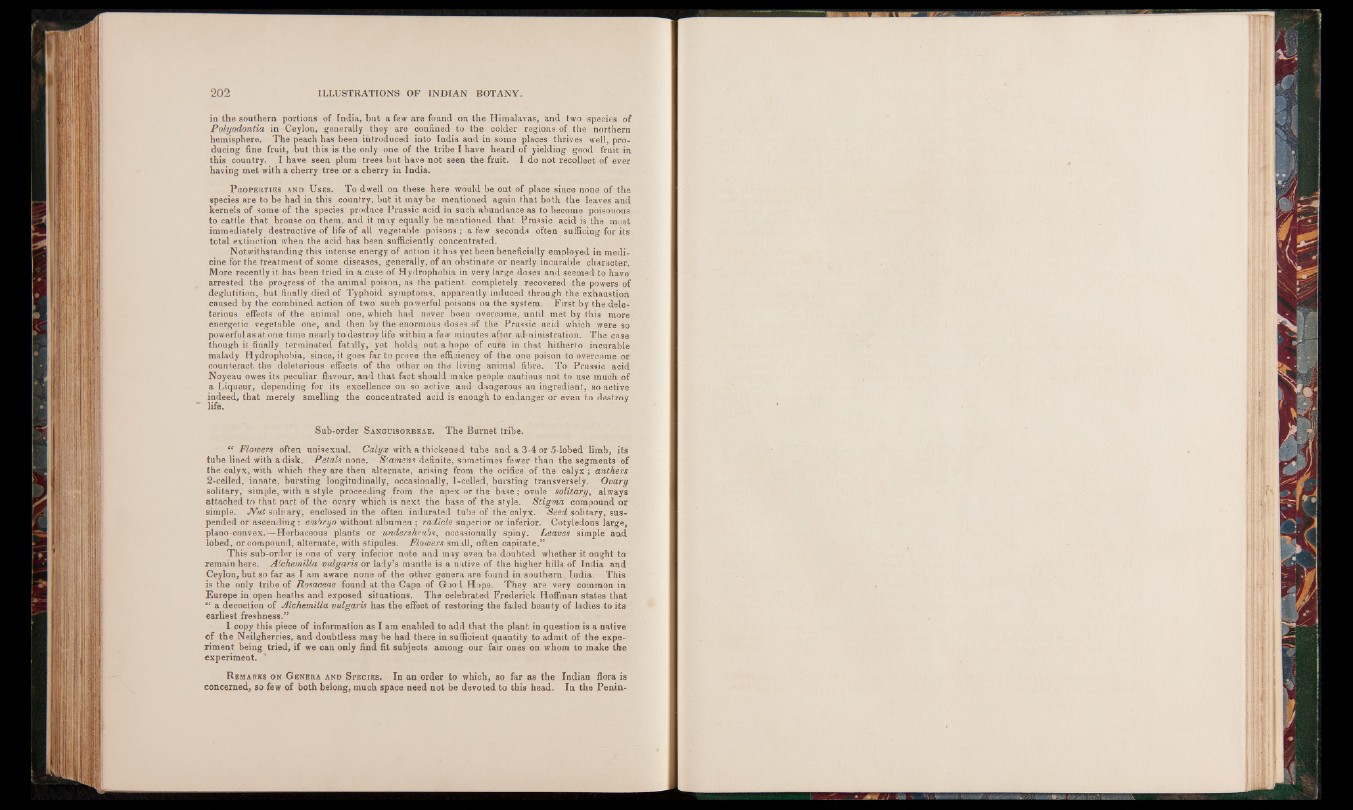
in the southern portions of India, but a few are found on the Himalayas, and two species of
P o lyo d o n tia in Ceylon, generally they are confined to the colder regions of the northern
hemisphere. The peach has been introduced into India and in some places thrives well, producing
fine fruit, but this is the only one of the tribe l have heard of yielding good fruit in
this country. I have seen plum trees but have not seen the fruit. I do not recollect of ever
having met with a cherry tree or a cherry in India.
P ro p erties and U s e s . To dwell on these here would be out of place since none of the
species are to be had in this country, but it may be mentioned again that both the leaves and
kernels of some of the species produce Prussic acid in such abundance as to become poisonous
to cattle that brouse on them, and it may equally be mentioned that Prussic acid is the most
immediately destructive of life of all vegetable poisons ; a few seconds often sufficing for its
total extinction when the acid has been sufficiently concentrated.
Notwithstanding this intense energy of action it has yet been beneficially employed in medicine
for the treatment of some diseases, generally, of an obstinate or nearly incurable character.
More recently it has been tried in a case of Hydrophobia in very large doses and seemed to have
arrested the progress of the animal poison, as the patient completely recovered the powers of
deglutition, but finally died of Typhoid symptoms, apparently induced through the exhaustion
caused by the combined action of two such powerful poisons on the system. First by the deleterious
effects of the animal one, which had never been overcome, until met by this more
energetic vegetable one, and then by the enormous doses of the Prussic acid which were so
powerful as at one time nearly to destroy life within a few minutes after administration. The case
though it finally terminated fatally, yet holds, out a hope of cure in that hitherto incurable
malady Hydrophobia, since, it goes far to prove the efficiency of the one poison to overcome or
counteract the deleterious effects of the other on the living animal fibre. To Prussic acid
Noyeau owes its peculiar flavour, and that fact should make people cautious not to use much of
a Liqueur, depending for its excellence on so active and~dangerous an ingredient, so active
indeed, that merely smelling the concentrated acid is enough to endanger or even to destroy
life.
Sub-order S anguisorbeae. The Burnet tribe.
tc Flowers often unisexual. C a ly x with a thickened tube and a 3-4 or 5-lobed limb, its
tube lined with a disk. Pe tals none. Stamen's definite, sometimes fewer than the segments of
the calyx, with which they are then alternate, arising from the orifice of the calyx; anthers
2-celled, innate, bursting longitudinally, occasionally, 1-celled, bursting transversely. Ova ry
solitary, simple, with a style proceeding from the apex or the base; ovule solita ry t always
attached to that part of the ovary which is next the base of the style. S tigm a compound or
simple. N u t solitary, enclosed in the often indurated tube of the calyx. S e e d solitary, suspended
or ascending: embryo without albumen ; radicle superior or inferior. Cotyledons large,
plano-convex.—Herbaceous plants or undershrubs, occasionally spiny. Leaves simple and
lobed, or compound, alternate, with stipules. Flowers small, often capitate.”
This sub-order is one of very inferior note and may even be doubted whether it ought to
remain here. A lch em illa vu lg a ris or lady’s mantle is a native of the higher hills of India and
Ceylon, but so far as I am aware none of the other genera are found in southern India. This
is the only tribe of Rosaceae found at the Cape of Good Hope. They are very common in
Europe in open heaths and exposed situations. The celebrated Frederick Hoffman states that
“ a decoction of Alchemilla vulgaris has the effect of restoring the faded beauty of ladies to its
earliest freshness.”
1 copy this piece of information as I am enabled to add that the plant in question is a native
of the Neilgherries, and doubtless may be had there in sufficient quantity to admit of the experiment
being tried, if we can only find fit subjects among our fair ones on whom to make the
experiment.
R emarks on G enera and S pec ie s . In an order to which, so far as the Indian flora is
concerned, so few of both belong, much space need not be devoted to this head. In the Penin